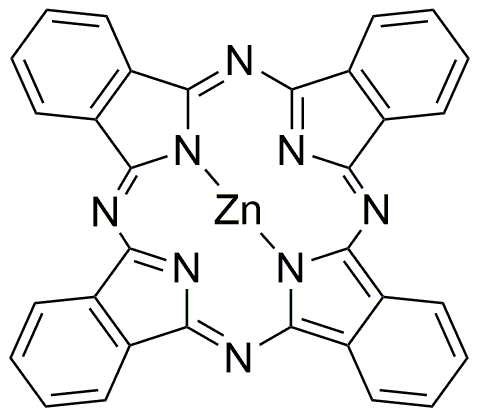Zinc phthalocyanine is widely utilized in research focused on:
- Photodynamic Therapy: This compound is effective in treating certain cancers by generating reactive oxygen species when exposed to light, helping to destroy tumor cells.
- Solar Energy Conversion: Its strong light-absorbing properties make it ideal for use in organic solar cells, enhancing their efficiency and stability.
- Colorants and Dyes: Zinc phthalocyanine is used in the production of high-performance pigments for inks, coatings, and plastics, providing vibrant colors and excellent durability.
- Electronics: In the field of organic electronics, it serves as a semiconductor material in organic light-emitting diodes (OLEDs) and field-effect transistors, contributing to the development of flexible and efficient devices.
- Environmental Applications: It is employed in photocatalysis for the degradation of pollutants, offering a sustainable method for wastewater treatment and air purification.
General Information
Properties
Safety and Regulations
Applications
Zinc phthalocyanine is widely utilized in research focused on:
- Photodynamic Therapy: This compound is effective in treating certain cancers by generating reactive oxygen species when exposed to light, helping to destroy tumor cells.
- Solar Energy Conversion: Its strong light-absorbing properties make it ideal for use in organic solar cells, enhancing their efficiency and stability.
- Colorants and Dyes: Zinc phthalocyanine is used in the production of high-performance pigments for inks, coatings, and plastics, providing vibrant colors and excellent durability.
- Electronics: In the field of organic electronics, it serves as a semiconductor material in organic light-emitting diodes (OLEDs) and field-effect transistors, contributing to the development of flexible and efficient devices.
- Environmental Applications: It is employed in photocatalysis for the degradation of pollutants, offering a sustainable method for wastewater treatment and air purification.
Documents
Safety Data Sheets (SDS)
The SDS provides comprehensive safety information on handling, storage, and disposal of the product.
Product Specification (PS)
The PS provides a comprehensive breakdown of the product’s properties, including chemical composition, physical state, purity, and storage requirements. It also details acceptable quality ranges and the product's intended applications.
Certificates of Analysis (COA)
Search for Certificates of Analysis (COA) by entering the products Lot Number. Lot and Batch Numbers can be found on a product’s label following the words ‘Lot’ or ‘Batch’.
*Catalog Number
*Lot Number
Certificates Of Origin (COO)
This COO confirms the country where the product was manufactured, and also details the materials and components used in it and whether it is derived from natural, synthetic, or other specific sources. This certificate may be required for customs, trade, and regulatory compliance.
*Catalog Number
*Lot Number
Safety Data Sheets (SDS)
The SDS provides comprehensive safety information on handling, storage, and disposal of the product.
DownloadProduct Specification (PS)
The PS provides a comprehensive breakdown of the product’s properties, including chemical composition, physical state, purity, and storage requirements. It also details acceptable quality ranges and the product's intended applications.
DownloadCertificates of Analysis (COA)
Search for Certificates of Analysis (COA) by entering the products Lot Number. Lot and Batch Numbers can be found on a product’s label following the words ‘Lot’ or ‘Batch’.
*Catalog Number
*Lot Number
Certificates Of Origin (COO)
This COO confirms the country where the product was manufactured, and also details the materials and components used in it and whether it is derived from natural, synthetic, or other specific sources. This certificate may be required for customs, trade, and regulatory compliance.


